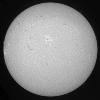





The Sun Now | Compare to Active Sun |
|---|---|
 |  |
Image Credit: Courtesy of the Big Bear Solar Observatory/New Jersey Institute of Technology. | |
| What layer does the light come from? | |
About the images:The red light of hydrogen alpha with a wavelength of 656.3 nm (1 nm = 1 billionth of a meter) is a very prominent feature in the solar light spectrum since hydrogen makes up 75% by weight of the outer layers of the sun. This light shows us layers up to 1700 km above the sun's visible surface and is especially important for imaging the lower chromosphere. The lower chromosphere is the coolest layer in the sun's atmosphere. Many features associated with solar activtiy are especially prominent in this type of image provided by the Learmonth Solar Observatory in Australia. |
|
What to look for:The H alpha picture of the sun is very useful in predicting eruptions. The bright regions around sunspots, called plages, and brilliant solar flares are easily seen at this wavelength. Filaments, vivid string-like regions, and sunspots, large blotches on the solar surface, appear dark. Filaments are common sources of eruptions. Filaments on the solar limb appear bright against the blackness of space and are called prominences. |
|
Connect me to the SOHO image gallery and the SOHO Movie Theater
Connect me to the Learmonth Solar Observatory
Connect me to the Big Bear Solar Observatory Latest Images
Last modified September 12, 2008 by Randy Russell.
The source of this material is Windows to the Universe, at http://windows2universe.org/ from the National Earth Science Teachers Association (NESTA). The Website was developed in part with the support of UCAR and NCAR, where it resided from 2000 - 2010. © 2010 National Earth Science Teachers Association. Windows to the Universe® is a registered trademark of NESTA. All Rights Reserved. Site policies and disclaimer.